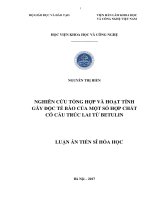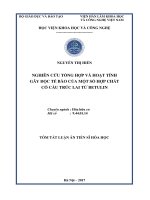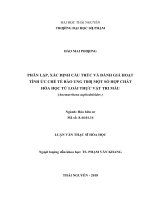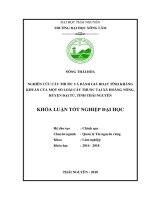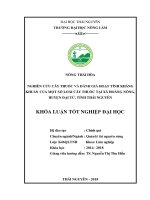Nghiên cứu tổng hợp và đánh giá hoạt tính gây độc tế bào của các hợp chất quinazolin tt tiếng anh
Bạn đang xem bản rút gọn của tài liệu. Xem và tải ngay bản đầy đủ của tài liệu tại đây (668.89 KB, 26 trang )
VIETNAM ACADEMY OF SCIENCE AND
TECHNOLOGY
INSTITUTE OF CHEMISTRY
------------------
RESEARCH ON THE SYNTHESIS AND EVALUATION
OF CYTOTOXIC ACTIVITY OF QUINAZOLINE
COMPOUNDS
Speciality
: Organic Chemistry
Code
: 9.44.27.01
Students
: Đinh Thuy Van
DISSERTATION SUMMARY
Ha Noi – 2019
1
The work was completed at the Vietnam academy of Science
and Technology
Supervisors:
Supervisor 1: Pro.Doc. Nguyen Van Tuyen
Supervisor 2: Doc. Dang Thi Tuyet Anh
Reviewer 1:
Reviewer 2:
Reviewer 3:
The thesis will be defended before the Doctoral Dissertation Council,
at the Academy of Science and Technology - Vietnam Academy of
Science and Technology. No. 18 - Hoang Quoc Viet, Cau Giay,
Hanoi.
At
...
time
...
2
..
…
2019
A. INTRODUCTION
1. The urgency, scientific and practical significance of the thesis
Quinazoline is a potential class in the design of synthetic anti-cancer
drugs according to the kinase enzyme inhibition mechanism [1-4]. Gefitinib
(Iressa), erlotinib (Tarceva), lapatinib (Tykerb) and vandetanib (Caprelsa) are
typical quinazoline compounds that have been introduced into the production of
cancer drugs. Among them Gefitinib and Erlotinib are the first epidermal growth
factor receptor(EGFR) chemotherapy drugs used to treat non-small cell lung
cancer. Erlotinb is a derivative of quinazoline with the trade name Tarceva,
produced by Hoffmann pharmaceutical company - La Roche. The drug is highly
effective for the treatment of non-small cell lung cancer (NSCLC) with EGFR
activating mutation. This is a breakthrough method in treating NSCLC that
creates an opportunity to prolong life time with higher quality of life. In
Vietnam, erlotinib hydrochloride Tarceva drug has not been widely used; first of
all because the cost of treatment with Tarceva is very high, 2,000 USD per
treatment cycle (one cycle = 1 month), price
in Vietnam market is about 42 million VND per bottle of 30 150mg tablets.
Therefore, the thesis "Research on synthesis and evaluation of cytotoxic
activity of quinazoline compounds" is a scientifically and practically
significant research direction.
2. Objectives of the dissertation
1. Research to improve the synthesis process of erlotinib hydrochloride drugs.
2. Research on the synthesis and determination of quinazoline derivative structure.
3. Research on the synthesis and determination of the structure of hybrid
compounds of quinazoline derivatives and azides via triazole bridges.
1
4. Research on cytotoxic activity of hybrid compounds synthesized on three
human cancer cell lines including KB (carcinoma, Hep-G2 (liver cancer) and
Lu (non-small cell lung cancer).
3. New points of the dissertation
a. Successfully synthesized erlotinib hidrocloride according to the new
improvement process
b. Synthesis of 23 new quinazoline derivatives in which there were 19
derivatives containing triazole rings:
* 4 derivatives of erlotinib and different azides via triazole bridges
* 4 derivatives of quinazoline-4- amine containing crown ether group in position
C-6, C-7 following a completely new path. These derivatives are used to
hybridize with other active azides via triazole bridges by click reaction.
* 15 hybrid compounds of quinazoline crown ether and azides via triazole
bridges c. The structure of new hybrid compounds has been confirmed from the
results of analysis of infrared spectral data (IR), nuclear magnetic resonance
spectroscopy (1H-NMR and 13C-NMR, HMBC, HSQC) and mass
spectroscopy (HRMS).
d. Evaluation of activity of 19 new quinazoline derivatives on three human
cancer cell lines including KB (carcinoma, Hep-G2 (liver cancer) and Lu
(non-small cell lung cancer) in which there are 13 substances that can cause
investigated cancer cell toxicity. Among them there are 8 substances exhibiting
strong anti-cancer cell activity with the value of IC50 from 2 to 6 µM.
e. Using protein docking simulation to predict the target activity of
compounds 120d, 122a, 122b, 123c
f. Synthesized Compound 122a which has the strongest inhibitory activity
for all three KB cell lines, Hep-G2 and Lu with IC 50 values of 0.04 µM, 0.14
µM and 1.03 µM, respectively, 100 times higher than erlotinib. The 123c
compound has IC50 value (1.49; 1.61; 1.81 µM) equivalent to the Ellipticine
standard (IC50 is 1.95; 2.72; 1.38 µM, respectively).
2
4. Structure of the dissertation
The dissertation consists of 129 pages including:
Introduction: 2 pages.
Chapter 1. Literature review: 31 pages
Chapter 2. Experiment: 25 pages.
Chapter 3. Results and discussion: 56 pages.
The reference section has 122 documents on the relevant areas of the
dissertation, updated to 2018.
The appendix consists of 62 pages, including the spectroscopy of
synthesized substances.
5. Research methodology
The substances were synthesized according to known modern organic
synthesis methods, improved and applied appropriately in specific cases.
Reaction products were cleaned by column chromatography and
recrystallization. The structure of the product was determined by modern
spectral methods such as IR, HRMS, ESI-MS, 1H-NMR,
13
C-NMR,
HMBC, HSQC, DEPT. Biological activity was explored according to the
method of Mossman on three cancer cell lines, KB, Hep-G2 and Lu.
Protein docking simulation was used to predict the target activity of
synthesized compounds.
B. CONTENTS OF THE DISSERTATION
CHAPTER 1. LITERATURE REVIEW
This chapter presents the following contents:
- The quinazoline synthesis methods
- The erlotinib synthesis methods
- Anti-cancer activity of quinazoline derivatives
- Click reaction
- Protein docking technique
3
CHAPTER 2. EXPERIMENT
The experiment section consists of 25 pages, detailing the research methods,
synthesis process, refining process, physical properties of received products
such as melting point, shape, color, reaction performance and detailed data
of IR, HRMS, 1H-NMR, 13C-NMR, HMBC, HSQC, DEPT.
CHAPTER 3: RESULTS AND DISCUSSION
3.1. OBJECTIVES OF THE DISSERTATION
This dissertation focused on the development of an optimal procedure for
erlotinib hydrochloride synthesis (diagram 3.1) to produce a synthesis
process of erlotinib hydrochloride that can be applied into production in
Vietnam, synthesizing new quinazoline derivatives (diagram 3.2) and hybrid
compounds of quinazoline frame and triazole group (diagram 3.3) to search
for new compounds with interesting biological activity.
Diagram 3.1: Synthesis process of erlotinib hydrochloride (93)
o
(a) BrCH2CH2OCH3, K2CO3, Bu4NHSO4, DMF, 110°C; (b) H2O, CH3OH, KOH, 30 C; (c) Urea,
210-220°C; (d) P2O5, xylene, Reflux; (e) HNO3, acid acetic ice, 0°C; (f) Na2S2O4, H2O,
HCl; (g) DMF-DMA, acid acetic, toluen, 105°C; (h) 3-ethynylaniline, acid acetic, toluen, 60o
110 C; (i) HCl gas, CH3OH, 15-20°C.
4
Diagram 3.2: Synthesis of quinazoline derivatives
containing crown ether group in position C-6, C-7
Reagents and conditions: (a) NH2OH.HCl, NaOH, MeOH, H2O, mix, 30-60 minutes, 95-98%;
o
(b) Ac2O, reflux, 8-12 h, 90-95%; (c) Na2S2O4, H2O, 50-65 C, 3-4 h, 80-85%; (d) 1,2dicloethan, or 1,3-dibrompropan, K2CO3, Bu4NHSO4, acetone, reflux, 10 h; (e) H2O, MeOH,
o
KOH, 30 C, 4 h; (f) Urea, 150-160 °C, 5 h; (g) P 2O5, xylene, reflux, 5 h; (h) HNO 3, acid
acetic ice, 0°C, 2 h (i) DMF-DMA, acid acetic, toluene, reflux, 4-6 h; (k) 3-etynylaniline, acid
o
o
acetic, toluene, 60 C-110 C, 4-6 h, 50-63%.
Diagram 3.3: Synthesis of hybrid compounds of quinazoline 119a-d
derivatives and azides via triazole bridges.
Reagents and conditions: 1 equiv 4-anilinoquinazoline 119a-d, 1,1 azide equiv, 12 equiv
DIPEA, 0,2 equiv CuI, THF, rt, 1-2 days, 70-90%.
5
3.2. SYNTHESIS OF ERLOTINIB HYDROCLORIDE
From the synthesis methods of erlotinib hydrochloride mentioned in the
reference as described in the diagrams 1.15-1.23 and the initial research
results of the authors, it was found that each method has its advantages and
disadvantages. The two biggest difficulties of the methods are the reduction
of the nitro group into the amino group and the 4-chloroquinazoline
intermediate synthesis reaction. In order to choose a path of synthesis of this
drug in accordance with the conditions in Vietnam, we carefully studied the
advantages and disadvantages of each method combined with the initial
research, we chose an appropriate method to study and improve the synthesis
of erlotinib hydrochloride as shown in diagram 3.1.
Product 93 was structured by modern spectral methods 1H-NMR,
13
C-
NMR. Erlotinib hydrocloride 93 is a yellow solid with the melting point 228229oC. IR 3277, 3053, 3021, 2922, 2896, 2820, 2745, 2710, 1667, 1564,
1510, 1446, 1284, 1122, 8920 cm-1. 1H-NMR (DMSO-d6) 11,45 (s, 1H,
NH); 8,81 (s, 1H, H-Ar); 8,30 (s, 1H, H-Ar); 7,90-7,72 (m, 2H, H-Ar); 7,537,33 (m, 3H, HAr); 4,45-4,25 (m, 4H, CH 2O); 3,79-3,70 (m, 4H, CH2O),
3,40 (s, 1H, C≡CH), 3,25 (s, 6H, OCH3).
13
C-NMR (DMSO-d6) 170,2;
159,1; 155,1; 151,2; 147,3; 142,3; 130,9; 125,8; 124,0; 122,3; 117,65; 114,2;
108,8; 100,9; 87,1; 80,6; 76,7; 73,5; 51,3.
3.3. SYNTHESIS OF HIBRID COMPOUNDS OF ERLOTINB-TRIAZOLE
The synthesis of hybrid structured compounds between two or more
bioactive substances is also a very interesting and new issue, now attracting
attention of many scientists. Synthesis of a hybrid compound from two
compounds with antitumor activity, especially those that act according to
6
different mechanisms of action, may increase activity or improve the
disadvantages of the original compounds. On the other hand, the hybrid
structured compounds when introduced into the body will be gradually
hydrolyzed by the enzymes in the body to produce the original substance,
thus reducing the side effects and increasing efficiency due to the long halflife . In order to find and expand interesting new activities of erlotinib
derivatives, we studied and synthesized the hybrid compounds of erlotinib
and azides via triazole bridges with click reaction. Results were 4 new
derivatives which were 105a-d.
HN
HN
N
HC
3
O
O
H3C
O
N
O
H3C O
N N
O2N
N
H3C
O
O
O
N
N
N N
NO2
N
105b
1210C, 83%
105a
1240C, 75%
CN
CF3
HN
HN
H3C O
O
H 3C
O
O
N
N
N
NO2
HC
3
N N
H3 C
O
O
N
O
O
105c
1020C, 86%
N
N N
N
105d
1400C, 90%
Figure 3.19: Chemical structure and some physical characteristics of
compounds 105a-d
The expected structure of hybrid compounds 105a-d is confirmed by their
IR, MS, 1H-NMR and 13C-NMR spectral data.
7
6,7-Bis(2-methoxyethoxy)-N-(3-(1-(3-nitro-phenyl)-1H-1,2,3-triazol-4yl)phenyl) quinazoline-4-amine 109b
HN
H 3C O
O
H3C
O
N
N
N
N
NO2
O
N
Colorless solid. MP 121oC. Yield 83%.
IR (KBr) cm-1: 2930, 1623, 1583, 1535, 1507, 1442, 1350, 1238, 1034, 928.
1
H-NMR (DMSO-d6, 500 MHz) δ: 9.61 (1H, s, NH), 9.56 (1H, s), 8.81 (1H,
t, J = 2 Hz), 8.51-8.47 (2H, m), 8.40 (1H, s), 8.35-8.33 (1H, m), 7.95-7.92
(3H, m), 7.67 (1H, d, J = 5.5 Hz), 7.53 (1H, t, J = 8 Hz), 7.23 (1H, s), 4.334.28 (4H, m, CH3OCH2CH2O), 3.81-3.75 (4H, m, CH3OCH2CH2O), 3.38
(3H, s, OCH3), 3.36 (3H, s, OCH3). 13C-NMR (DMSO-d6, 125 MHz) δ:
156.4, 153.6, 152.9, 148.6, 148.1, 147.7, 140.2, 137.2, 131.6, 103.2, 129.2,
125.9, 123.1, 122.4, 120.6, 120.1, 119.1, 114.6, 108.2, 103.3, 70.1, 70.0,
68.4, 68.1, 58.4, 58.3. LC-MS/MS (m/z) Calc. for: C28H28N7O6: 558.2023
[M+H]+, found: 558.2061.
3.4. SYNTHESIS OF HIBRID COMPOUDS OF QUINAZOLINE
DERIVATIVES CONTAINING CROWN ETHER GROUP IN
POSITION C-6, C-7.
Studies on the relationship between structure and biological activity
(SAR) of EGFR inhibitors showed that the 4-anilinoquinazoline frame is
important for EGFR inhibitory activity, and substituents at the position C-6 and
C-7 mainly contributing to their physical and chemical properties with good
compatibility with bulky branches [15,16,104,105]. With these advantages, in
recent years, many 4-anilinoquinazoline derivatives have been designed and
synthesized consecutively. Among them, anilinoquinazoline
8
analogues are combined with new tyfin EGFR inhibitors [17,106,107]. The
SAR shows that oxygen-containing heterocyclic rings with 12 members
higher ring size are fused anilinoquinazoline, and the preferred substituents
on 4-anilino is a halogen such as chlorine, bromine, or phenyl group in the
meta position [17,107]. Some of them have been proved to be active in
EGFR-mediated phosphorylated assays in human tumor cells A431 [17]
while another showed strong activity against dissociation by inhibition of
both tyrosine kinase receptors including EGFR, VEGFR, PDGFR, and
nonreceptor TKs includes C-Src and Abl kinase with higher inhibitory
activity against EGFR [107]. According to the results mentioned above, and
from erlotinib, we devised and synthesized the series of quinazoline
incorporating dioxygenated rings containing the ethynyl group in the meta
position of aniline without rings, for the purpose of collecting the agent
showing stronger anti-cancer activities.
In this study, the synthesis of quinazoline 119a-d crown ether through 5-6
steps with two different paths. One is from different benzaldehydes, two is
from acid 106 3.4- dihidroxy benzoic as described in diagram 3.14. The
fusion of quinazoline derivatives is showed in diagram 3.2
The results were 4 quinazoline derivatives containing crown ether group at
position C-6, C-7
9
Figure 3.26: Structure of 4 4-aminoquinazoline compounds containing
crown ether group at position C-6, C-7 119a-d.
The structure of compounds 119a-d was determined simply based on spectral
data analysis, including IR and 1H-NMR, HRMS.
3.5. SYNTHESIS OF HIBRID COMPOUNDS OF
QUINAZOLINE-TRIAZOLE
The synthesis of hybrid compounds of 4-anilinoquinazoline and azides
via triazole bridge, the results were a number of new hibrid compounds with
3 components. 4-anilinoquinazoline was the skeleton, triazole cycle and aryl
were chained with variable substituents. Most EGFR-tyrosine kinase
inhibitors have the same set of 4-anilinoquinazoline, only substituents and
side chains changed. Therefore, the replacement of the acetylene moiety at
the C3 position of the phenyl ring by a triazole nucleus could rigid the
structure of the nucleus. Thus hydrogen bond between triazole ring and
peptide backbone of EGFR receptors could afford specifc conformations,
thereby improving inhibitory activities of hybrid compounds. Besides, with
respect to the triazolyl substituent, we consider their influence on bioactive
function including nitrophenyl and cyanotrifluoromethylphenyl. Due to the
10
specifc chemical and physical properties of nitrogen and fluorine, the
introduction of a NO2, CF3, and CN moieties in pharmacologically active
compounds is known to convey beneficial biological effects to the resulting
molecules. Hence organic and medicinal chemists are increasingly interested
in polyfunctional NO2–, CF3-, and CNsubstituted scaffolds. In that respect,
copper(I)-catalyzed azide alkyne cycloaddition (CuAAC) 119a-d with
nitrophenyl- and cyanotrifluoromethylphenylazides generating the target 4anilinoquinazoline–substituted triazole hybrid compounds 120–123a-d in
70–90% yields (diagram
3.3). The13structure of hybrid compounds 11–14 was
1
determined by
their
H
NMR, C NMR, and MS (ESI) spectroscopy.
Notably, the 1H NMR spectroscopy showed a pic singlet
at 9.17–9.65 ppm
corresponding to the triazolyl proton, while the 13C NMR spectroscopy
showed peaks at 120–123 ppm and 147–149 ppm corresponding to
characteristics CH and Cq of the triazole core unit.
Synthesis reaction of hybrid compounds according to diagram 3.3
The obtained results were 4 ranges of hybrid compounds of compounds
119a-d 3.5.1. Synthesis of hybrid compounds of derivatives 119a
Hybrid compounds of 120a-d are all colorless crystals. MP: 186-267 oC.
Yield 72%-90%.
120a, 212oC, 87%
120b, 242-243oC, 87%.
11
120c, 267 o C. 72%
120d, 186oC, 90%
Figure 3.32: Chemical structure and physical characteristics of hybrid
compounds 120a-d
The structure of compound 120a was proved by IR, NMR spectroscopy.
N-(3-(1-(2-nitrophenyl)-1H-1,2,3-triazol-4-yl)phenyl)quinazolin-4-amine (120a)
Colorless solid. MP: 212oC. Yield 87%. IR (KBr) 3132, 2924, 2853,
1611, 1568, 1538, 1492, 1411, 1354, 1033, 924, 888, 773 cm -1. 1H-NMR
(DMSO-d6, 500 MHz) δ 9.96 (1H, s, NH), 9.19 (1H, s), 8.65 (1H, s), 8.62
(1H, d, J = 8 Hz), 8.50 (1H, t, J = 1.5 Hz), 8.26 (1H, d, J = 7.5 Hz), 8.037.95 (3H, m), 7.88 (2H, t, J = 7 Hz), 7.82 (1H, d, J = 7.5 Hz), 7.68-7.65 (2H,
m), 7.54 (1H, t, J = 8 Hz). 13C-NMR (DMSO-d6, 125 MHz) δ 157.9, 154.5,
149.7, 147.1, 144.1, 139.9, 134.5, 133.1, 131.3, 130.2, 129.3, 129.1, 127.8,
127.5, 126.4, 125.6, 123.0, 122.9, 122.5, 121.0, 119.3, 115.2. ESI-MS (m/z)
Calc. for: C22H16N7O2: 410.1287 [M+H]+; Found: 410.3196.
The structure of substances 120b-d was similarly demonstrated to compound
120a by IR, NMR, and MS spectroscopy.
3.5.2. Synthesis of hybrid compounds of derivative 119b
12
121a
121b
121c
121d
Structure of hybrid compounds of substance 119b
The structure of hybrid compound 121d was proved by IR, NMR, HSQC,
HMBC, DEPT, MS spectra.
5-(4-(3-([1,3]Dioxolo[4,5-g]quinazolin-8-ylamino)phenyl)-1H1,2,3-triazol-1-yl)-2-(trifluoro-methyl)benzonitrile (121d)
Light yellow solid. MP: 256-257oC. Yield 90%.
IR (KBr) 3282, 3132, 2238 (CN), 1615, 1580, 1529, 1493, 1470,
1439, 1386, 1315, 1271, 1242, 1217, 1183, 1135, 1030, 911, 845, 790, 688
cm-1. 1H-NMR (DMSO-d6, 500 MHz) δ 9.60 (1H, s, H-triazole), 9.53 (1H, s,
NH), 8.59 (1H, s, H-19), 8.54 (1H, d, J = 8.5 Hz, H-23), 8.49 (1H, s, H-2),
8.47 (2H, m, H-11, H-22), 8.14 (1H, s, H-5), 7.93 (1H, d, J = 8 Hz, H-15),
7.63 (1H, d, J = 7.5 Hz, H-13), 7.52 (1H, t, J = 8 Hz, H-14), 7.19 (1H, s, H9), 6.25 (2H, s, OCH2). 13C-NMR (DMSO-d6, 125 MHz) δ 156.9 (C-4),
153.0 (C-2), 152.4 (C-6), 148.6 (C-9a), 148.0 (C-16), 147.3 (C-8), 140.3 (C13
10), 139.7 (C-18), 137.5 (C-22), 132.7 (q, J = 32.5 Hz, C-21), 129.8 (C-12),
129.2 (C-14), 123.7 (C-23), 122.2 (C-15), 120.4 (C-13), 120.2 (C-17), 118.9
(C-11), 1181 (C-19), 115.0 (C≡N), 110.2 (C-4a), 107.7 (C-20), 104.6 (C-9),
102.3 (C-7), 98.9 (C-5). HRMS calc. for : C 25H15F3N7O2: 502.1161 [M+H]+;
Found: 502.1233.
The structure of substances 121a-c was proved similarly to 121d by
IR, NMR, MS spectra.
3.5.3 Synthesis of hybrid compounds of derivative 119c
The synthesized results of hybrid compounds of compound 119c were 4
hybrid compounds 122a-d
The structure of compound 122a was proved by IR, NMR, HSQC, HMBC,
DEPT, MS spectra.
N-(3-(1-(2-nitrophenyl)-1H-1,2,3-triazol-4-yl)phenyl)-7,8-dihydro
dioxino [2,3-g] quinazolin-4-amine (122a)
[1,4]
Light yellow solid. Yield: 80%. MP: 195oC.
IR (KBr) 3134, 1603, 1568, 1531, 1505, 1415, 1348, 1289, 1220,
1066, 901 cm-1. 1H-NMR (DMSO-d6, 500 MHz) δ 9.67 (1H, br.s, NH), 9.17
(1H, s), 8.49 (2H, s), 8.26 (1H, d, J = 8 Hz), 8.14 (1H, s), 8.02-7.97 (2H, m),
7.95 (1H, d, J = 8 Hz), 7.88 (1H, t, J = 8 Hz), 7.63 (1H, d, J = 7.5 Hz), 7.51
(1H, t, J = 8 Hz), 7.19 (1H, s), 4.42 (4H, d, J = 3.5 Hz, OCH2). 13C-NMR
(DMSO-d6, 125 MHz) δ 156.7, 152.9, 149.2, 147.1, 145.7, 144.1, 143.7,
140.2, 134.5, 131.3, 130.1, 129.2, 129.1, 127.5, 125.6, 122.8, 122.1, 120.6,
14
118.9, 112.3, 110.0, 108.5, 64.5, 64.2. HRMS (ESI+) m/z calc. for:
C24H18N7O4 [M+H]+ 468.1342, Found: 468.1416.
The structure of the remaining compounds is proved by IR, NMR, MS spectra.
3.5.4 Synthesis of hybrid compounds of derivative 119d
The structure of the compounds 123a-c was proved by IR, NMR, MS spectra.
N-(3-(1-(2-nitrophenyl)-1H-1,2,3-triazol-4-yl)phenyl)-8,9-dihydro7H-[1,4] dioxepino[2,3-g]quinazolin-4-amine (123a)
Colorless solid. MP: 278oC. Yield 79%.
IR (KBr) 2926, 1609, 1574, 1537, 1479, 1415, 1350, 1330, 1064,
991 cm-1. 1H-NMR (DMSO-d6, 500 MHz) δ 9.81 (1H, s, NH), 9.17 (1H, s),
8.58 (1H, s), 8.48 (1H, s), 8.26 (1H, dd, J = 8 Hz, J = 1 Hz), 8.18 (1H, d, J =
9 Hz), 8.02-7.97 (2H, m), 7.91 (1H, d, J = 8 Hz), 7.89 (1H, td, J = 8.5 Hz, J
= 2 Hz), 7.65 (1H, d, J = 8 Hz), 7.51 (1H, t, J = 8 Hz), 7.26 (1H, d, J = 9
Hz), 4.36-4.31 (4H, m, OCH2), 2.24 (2H, t, J = 5.5 Hz, OCH2CH2CH2O).
13
C-NMR (DMSO-d6, 125 MHz) δ 157.7, 154.3, 153.0, 147.2, 144.2, 140.1,
134.7, 131.5, 130.2, 129.4, 129.2, 127.6, 125.7, 122.9, 122.6, 121.1, 121.0,
119.4, 117.5, 70.8, 70.7, 30.9. HRMS calc. for: C25H20N7O4: 482.1499
[M+H]+; Found: 482.1573.
3.6. INVESTIGATION OF CYTOTOXIC ACTIVITY OF
QUINAZOLINE, QUINAZOLINE-TRIAZOLE COMPOUNDS
3.6.1. Results of cytotoxic activity test
The process of investigating cytotoxic activity was performed at the
Applied Biochemistry Department of the Institute of Chemistry. The
compounds after synthesis were evaluated cytotoxic activity with 3 human
15
cancer cell lines, including KB (carcinoma, Hep-G2 (liver cancer) and Lu
(non-small cell lung cancer). We used Erlotinib, erlotinib hydrochloride
(non-small cell lung cancer preparation material) and ellipticine as a positive
control. As shown in Table 3.5, in general, synthesized compounds showed
good cytotoxic inhibitory effects in most cases and had higher inhibitory
activity than erlotinib referred and erlotinib hydrochloride drugs .
No
1
2
3
4
5
6
7
8
9
10
11
12
13
14
15
16
17
18
19
20
21
22
Table 3.5: Cytotoxic activity of synthesized compounds
comp
IC50
IC50
IC50
R1,R2
R
ound
(KB),
(HepG2)
(Lu),
s
µM
, µM
µM
5.46
4.16
4.16
119a
120a
5.50
4.64
4.76
2-NO2
H
104.20
286.75
259.74
120b
3-NO2
5.47
8.11
9.16
120c
4-NO2
1.46
1.86
4.50
120d
3-CN-4-CF3
119b
75.60
26.17
64.88
121a
193.33
207.01
216.84
2-NO2
6.35
6.88
6.66
121b
-OCH2O3-NO2
30.10
11.29
44.48
121c
4-NO2
4.59
6.10
27.46
121d
3-CN-4-CF3
119c
2.60
2.84
3.36
122a
0.04
0.14
1.03
2-NO2
3.51
0.88
5.67
122b
-O(CH2)2O3-NO2
79.09
230.02
54.77
122c
4-NO2
0.27
6.09
4.44
122d
3-CN-4-CF3
119d
54.83
69.89
80.67
123a
20.44
43.35
14.75
2-NO2
-O(CH2)3O53.17
76.81
230.40
123b
3-NO2
1.49
1.61
1.81
123c
3-CN-4-CF3
Erlotinib
13.01
25.01
99.76
Erlotinib.HCl
49.62
14.17
31.15
Ellipticine
1.95
2.72
1.38
16
Substitution by different oxygen substituent heterocycles on the positions 6 and 7 of
quinazolines skeleton affected the cytotoxic inhibition differently. Compound 119a and the
dioxane derivative 119c are clearly more preferred than dioxolane and dioxepine derivatives
119b, 119d. The effect of these unfavorable substitutions may result from steric hindrance.
Moreover, compounds 119a and 119c were found to be more potent cytotoxic inhibitors
against all three cancer cell lines than erlotinib and erlotinib hydrochloride with IC 50-values
ranging from 2 to 6 µM.
The coupling of substituted 1,2,3-triazolyl groups with targeted
dioxygenated ring fused quinazolines 119a–d at the anilino side chain was
found to greatly enhance the cytotoxicity of the resulting hybrid compounds
120-123. It is important to note that these separate pharmacophores and the
reference drugs display considerably less potent cytotoxic activities (IC 50values ranging from 2 to 100 µM) as compared to the most promising
conjugates 120a, c, d, 121b, d, 122a, b , d and 123c (IC50-values ranging
from 0.04 µM to 25 µM) showing a reasonable activity against these cancer
cell lines. Preliminary investigation of the structure–activity relationships
(SAR) of these synthesized hybrid compounds 120-123 revealed that the
nature of the oxygen substituent heterocycles and the aryl group which
connected to the triazole influenced the cytotoxicity activity remarkably. For
instance, the result revealed that the cytotoxic activity of dioxane substituted
analogues 122a-d are more potent than those of the corresponding
dioxolane, dioxepine counterparts, and the analogues without oxygen
substituent heterocycles (IC50: 122a> 120a>
123a> 121a, 122b> 121b> 123b> 120b, 122d> 123c ≈ 120d> 121d).
Especially, compound 122a displayed the most potent inhibitory activity
17
against KB, HepG2, and Lu with IC 50-values of 0.04 µM, 0.14 µM, and 1.03
µM, respectively, which was up to 100 fold higher than those of erlotinib.
The introduction of an electron-withdrawing groups such as NO 2, CF3, and
CN of the aryl which connected to the triazole can remarkable improve the
cytotixic activities. Substitution by a trifluoromethyl group of the aryl
seemed to be better than a nitro (IC 50: 120d> 120a> 120c> 120d, 121d>
121b> 121c> 121b, 123c> 123a> 123b). In addition, the effects of the
substituent position seemed to be also dependent on the substituent nature. In
fact, with a nitro substituent, substitution at ortoposition was better than at
meta- or para-positions in most cases .
3.6.2. Docking method on synthesized compounds on EGFR receptors
New compounds were designed and synthesized based on the
structural framework of typical quinazoline compounds, especially erlotinib.
Among those compounds there were compounds 120d, 122a, 122b, 123c
with very good cytotoxic activity, especially compound 122a showed the
strongest inhibitory activity for all three KB cell lines, Hep-G2 and Lu with
IC50 values are 0.04 µM, 0.14 µM and 1.03 µM respectively, 100 times
higher than erlotinib.
Protein docking simulation method was used. Protein docking is a
modeling technique that predicts a favorable position and structure that the
molecule can bind to its target targets, usually protein molecules. Due to
erlotinib's ability to inhibit EGFR non-activation and EGFR-TKD mutations
in non-small cell lung cancer cells (non-small-cell lung cancer, NSCLC) we
aimed at studying interaction between 120d, 122a, 122b, 123c with different
phenotypes of EGFR.
To prepare protein models, we collected and processed X-ray crystalline
structures of EGFR from the PDB Protein Bank ( 1)
18
EGFR activated without mutation under code 1M17 and 2ITX, 2) EGFR
activated with mutation L834R under code 2ITV, and 3) EGFR inactive
under code 4HJO and 1XKK. Compounds 120d, 122a, 122b, 123c were
built using 3D structure. LigPrep-Schrodinger software was used
( Docking simulation was done on
ICM-pro version 3.8 (www.molsoft.com/icmpro).
The docking results showed that all 4 compounds 120d, 122a, 122b, 123c
had good interaction with EGFR both in the active (mutation or not
mutation) and inactive form Figure 3.47. Due to the oil body characteristics
of the center activity of all three targets, the aminoquinazoline framework
created a dense network of van der Waals interactions with important amino
acids such as Leu844, Val726, Ala743, Lys745 of the L858R mutation. In
addition, the triazole group also strongly interacted with oil body amino
acids at the top of the bag like Lys745. In general, the first compounds
showed the ability to inhibit EGFR both in active and inactive forms.
However, unlike erlotinib, all four compounds exhibited weaker activity on
activated EGFR targets (with or without mutations), while activity on
inactive EGFR targets was stronger. The binding energy calculated for
Erlotinib on all three systems ranged from -7.1 to 9.9 kcal / mol. Meanwhile,
compounds 120d, 122a, 122b, 123c showed higher levels of interaction
energy with active EGFR than erlotinib (from -10.0 to -10.6 kcal / mol). The
energy calculated for inactive EGFR system is higher (from -10.6 to -12.3
kcal / mol).
In summary, the molecular docking simulation results helped predict the
target activity of compounds 120d, 122a, 122b, 123c, contributing to
explaining the cytotoxic mechanism of these compounds. Combining
theoretical and experimental research on compound 122a can be considered
19
a new hit, guiding the synthesis of new navigation compounds that inhibit
EGFR, the future treatment of lung cancer.
Compound 120d
Compound 122a
Compound 122b
Compound 123c
Figure 3.47: 2D diagram showing docking interaction of compounds
120d, 122a, 122b, 123c with active sites of 3 target EGFR proteins.
(In which atoms were classified by color, the number in the cells is the
binding energy (kcal / mol) of the compounds).
120d
122a
IC50 (µM): 1.46 (KB); 1.86
IC50 (µM): 0.04 (KB); 0.14
(HepG2);
(HepG2); 1.03 Lu
20
119c
122b
IC50 (µM): 2.6 (KB); 2.84 (HepG2);
IC50 (µM): 0.88 (HepG2);
122d
123c
IC50 (µM): 1.49 (KB); 1.61
(HepG2); 1.81( Lu)
IC50 (µM): 0.27 (KB);
Figure 3.48: Structure of some hybrid compounds with good activity
21
CONCLUSION
1. Successfully synthesized erlotinib hydrochloride according to the
improved process.
2. Synthesized 39 substances including 23 quinazoline derivatives; 19 new
hybrid compounds not yet seen in previous publications including:
* 4 hybrid compounds of erlotinib –triazole.
* 4 hybrid compounds of N- (3-ethynylphenyl) quinazoline-4-amine (119a)
and azides via triazole bridges.
* 4 hybrid compounds of N- (3-ethynylphenyl) - [1,3] dioxolo [4,5-g]
quinazoline-8-amine (119b) and azides via triazole bridges.
* 4 hybrid compounds of N- (3-ethynylphenyl) -7,8-dihydro- [1,4] dioxino
[2,3-g] quinazoline-4-amine (119c) and azides via triazole bridges.
* 3 hybrid compounds of N- (3-ethynylphenyl) -8,9-dihydro-7H- [1,4]
dioxepino [2,3-g] quinazoline-4-amine (119d) and azides via triazole
bridges.
3. Demonstrated the structure of 19 new hybrid compounds with modern
spectral methods such as IR, 1H-NMR, 13C-NMR, DEPT, HSQC,
HMBC, high-resolution mass spectra (HRMS).
4. Tested cytotoxic activity on 19 synthesized compounds on three cancer
cell lines in humans KB, Hep-G2 and Lu. The results showed that many
hybrid compounds have very good activity, much better than erlotinib
such as compounds 120a, 120d; 121b, 121d; 122a, 122b, 122d and
123c. In particular, compound 122a showed the strongest inhibitory activity
for all three cell lines KB, Hep-G2 and Lu with an IC50 value of 0.04
µM, 0.14 µM and 1.03 µM, respectively, 100 times higher than erlotinib.
22
5. Used protein docking simulation to predict the target activity of
compounds 120d, 122a, 122b, 123c, contributing to explaining the
cytotoxic mechanism of these compounds.
23

